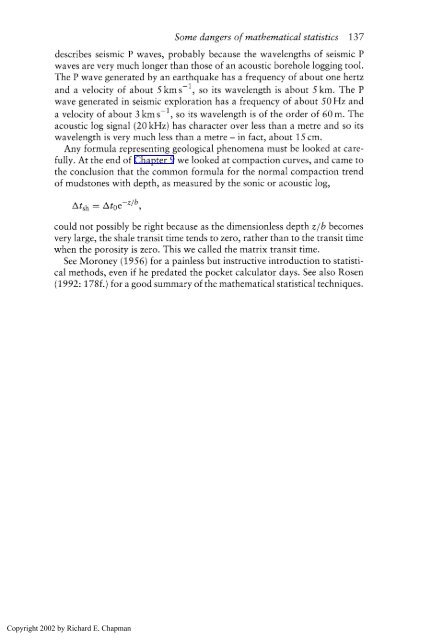Physics for Geologists, Second edition
Physics for Geologists, Second edition
Physics for Geologists, Second edition
Create successful ePaper yourself
Turn your PDF publications into a flip-book with our unique Google optimized e-Paper software.
Some dangers of mathematical statistics 137<br />
describes seismic P waves, probably because the wavelengths of seismic P<br />
waves are very much longer than those of an acoustic borehole logging tool.<br />
The P wave generated by an earthquake has a frequency of about one hertz<br />
and a velocity of about 5 kms-I, so its wavelength is about 5 km. The P<br />
wave generated in seismic exploration has a frequency of about 50 Hz and<br />
a velocity of about 3 km s-l, so its wavelength is of the order of 60 m. The<br />
acoustic log signal (20 kHz) has character over less than a metre and so its<br />
wavelength is very much less than a metre - in fact, about 15 cm.<br />
Any <strong>for</strong>mula representing geological phenomena must be looked at care-<br />
fully. At the end of Chapter 9 we looked at compaction curves, and came to<br />
the conclusion that the common <strong>for</strong>mula <strong>for</strong> the normal compaction trend<br />
of mudstones with depth, as measured by the sonic or acoustic log,<br />
could not possibly be right because as the dimensionless depth z/b becomes<br />
very large, the shale transit time tends to zero, rather than to the transit time<br />
when the porosity is zero. This we called the matrix transit time.<br />
See Moroney (1956) <strong>for</strong> a painless but instructive introduction to statisti-<br />
cal methods, even if he predated the pocket calculator days. See also Rosen<br />
(1992: 178f.) <strong>for</strong> a good summary of the mathematical statistical techniques.<br />
Copyright 2002 by Richard E. Chapman






